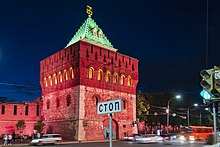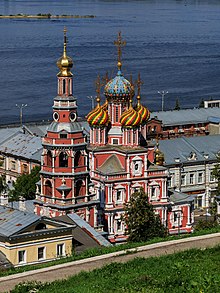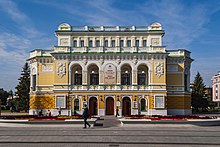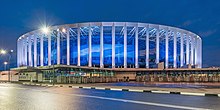Nizhny Novgorod
| city
Nizhny Novgorod
Нижний Новгород
|
|||||||||||||||||||||||||||||||||||||||||||||||
|
|||||||||||||||||||||||||||||||||||||||||||||||
|
|||||||||||||||||||||||||||||||||||||||||||||||
| List of cities in Russia | |||||||||||||||||||||||||||||||||||||||||||||||
Nizhny Novgorod ( Russian Нижний Новгород ( ); 1932 to 1990 Gorki , Russian Горький ) is the fifth largest city in Russia with 1.26 million inhabitants (as of 2018) and more than two million in the region . It is located around 400 km east of Moscow at the confluence of the Oka with the Volga and is the capital of the Nizhny Novgorod Oblast and the Volga Federal District .
The city, which is important for Russian history, developed into a hub of Russian trade around 1850 and an important industrial metropolis during the Soviet era. Today Nizhny Novgorod is an important political, economic, scientific and cultural center of Russia. It is the largest transportation hub and government center of the Volga Federal District and one of the main destinations of river tourism in Russia. In the city center there are universities, churches, museums and theaters. The Kremlin is the most important structure in the old town of Nizhny Novgorod . The city authorities are concentrated on its territory.
history
Medieval prince seat
The city was founded in 1221 by Yuri II Vsevolodovich , Grand Duke of Vladimir-Suzdal , at the confluence of the two most important rivers of his territory, the Volga and the Oka. The literal translation of Nizhny Novgorod is "Lower New Town". It is possible that this name was given to her to distinguish it from the older Novgorod . Like Moscow and Tver , Nizhny Novgorod was one of those newly founded cities that escaped the devastation of the Mongols due to their insignificance at the time, but then became important during the period of the "Tatar Yoke" (rule of the Golden Horde from the 13th to 15th centuries) political centers developed. The importance of Nizhny Novgorod continued to grow after it was declared the capital of the principality of the same name in 1341 , which separated from Vladimir-Suzdal. The Grand Duke Dimitri Konstantinowitsch (1328-1383) tried to make the capital of his empire an equal rival of Moscow. He began to build the Kremlin , the stone fortress, as a protection against the Tatars. According to historiography, he also made a name for himself in building several churches. On his behalf, the oldest surviving copy of the famous Nestor Chronicle was created in 1377 by the monk Lavrenti .
In 1378 the city was destroyed by the troops of Mamai , the emir of the Golden Horde.
Mightiest fortress in the Moscow Empire
After the city became part of the Grand Duchy of Moscow in 1392 , the princes of Nizhny Novgorod called themselves "Shuiskie" and moved to Moscow, where they held important positions at court and briefly ascended the throne with Vasily IV . Nizhny Novgorod was seen by the Muscovites as an important fortress in their wars against the Kazan Tatars . The massive red brick Kremlin, one of the most powerful and oldest preserved Russian fortresses, was built between 1508 and 1511 under the direction of "Peter the Italian". When the Tatars besieged the fortress in 1520 and 1536, it turned out to be strong enough to withstand the attacks. After the conquest of Kazan by the Grand Duke of Moscow in 1552, the city's economic importance grew, as Moscow now ruled the entire Volga route. In 1612, a people's armed forces set up by the Nizhny Novgorod merchant Kusma Minin and led by Prince Dmitri Posharski drove the Polish troops out of Moscow, thereby ending the so-called " Time of Troubles ". Minin's bones lie in the Nizhny Novgorod Kremlin .
In the course of the 17th century the city experienced an economic boom and was chosen by the Stroganovs , one of the richest merchant families in Russia, as a base and settlement for their businesses. The specific architectural and icon style that emerged in Nizhny Novgorod around 1700 is known as the “Stroganov School”. In 1719 the city became the center of a governorate.
Great trading city

In 1817 the Makarev Fair , one of the busiest trading markets in the world at the time, was relocated to Nizhny Novgorod, which has attracted millions of visitors to the city year after year since then. In the middle of the 19th century it had established itself as the trading city of the Russian Empire. Other industries began to develop, and at the beginning of the 20th century the city was also one of the most important industrial centers in the country. The desolate life of the proletariat in this city is realistically described in the novels of Maxim Gorky , who was born in Nizhny Novgorod. A famous saying that reflects Nizhny Novgorod's importance as a trading city is: Moscow is the heart of Russia, Petersburg is the head and Nizhny Novgorod is its pocket.
Soviet city

The city was renamed Gorki (Горький) in 1932 after Maxim Gorky was officially recognized as a proletarian writer. Only after the political change in 1990 did it get its old name back.
In the 1930s, Gorky received the status of a “ closed city ” that foreigners were not allowed to visit. The reason for this was the factories located here that also manufactured armaments. In 1932 an automobile and an aircraft factory were opened. Nuclear submarines (of the Charlie class ), combat aircraft (such as the MiG-29 or the MiG-31 ) and tanks were produced in Gorky . It wasn't until 1991 that the city was reopened to visitors.
Also in the 1930s, Gorky overtook the cities of Saratov and Rostov-on-Don , which were even larger in the 1926 census, in terms of inhabitants , thus becoming the third largest city of the RSFSR and remained so until the end of the 1980s when it was surpassed by Novosibirsk (and in 2005 by Yekaterinburg ).
During the Second World War , the city rose to become the largest arms location in the country. In 1941, anti-tank barriers were erected on the outskirts and the production of armaments was expanded. Even ammunition and the famous Katyusha rockets have now been produced here. By 1945, the German Air Force had carried out 47 attacks on the city to destroy the armaments factories. The POW camp 112 was set up in the Ssormowo district in 1945 , and all of its inmates were only captured in Bohemia after the capitulation on May 8, 1945.
In the 1960s to 1980s, the city, like all major Soviet cities, was expanded significantly through the construction of new residential areas in prefabricated construction . In 1985 the Gorkier Metro was opened.
From 1980 to 1986 the city was the place of exile of the atomic physicist Andrei Sakharov . Sakharov fell out of favor with the communist regime after speaking out against the entry of Soviet troops into Afghanistan . He was expelled from Moscow and lived in Gorky under constant surveillance by the KGB in an apartment that can now be visited as the Sakharov Museum . In 1986 he got permission from Mikhail Gorbachev to return to Moscow.
Nizhny Novgorod in the Russian Federation
Already in the period of perestroika and well into the 1990s, the city was considered a pioneer of market economy reforms. While other regions of Russia still clung to the old system, this one was particularly progressive.
In 2000, as part of the restructuring of the administrative structure of Russia under President Putin , Nizhny Novgorod became the capital of the Volga Federal District , the head of which was installed by former Prime Minister Sergei Kiriyenko . On February 9, 2012, the cable car between Nizhny Novgorod and Bor was opened on the opposite bank of the Volga. The S-Bahn started on June 24, 2013 .
On September 22, 2015, Vladimir Putin signed the decree "On the occasion of the 800th anniversary of the founding of the city of Nizhny Novgorod" with the recommendation that the state authorities of the constituent groups of the Russian Federation and local governments take part in the preparation and implementation of the celebration of the 800th Participate in the anniversary of the founding of the city of Nizhny Novgorod.
population
Overview
The ethnic composition of the city is largely homogeneous. Around 95 percent of the city's residents belong to the ethnic group of Russians . The mean age of the population in 2011 was 39.9 years. 64 percent of the population were of working age. In 2009 there were 358,000 retired people in the city, 30 of whom were over 100 years old. In 2012 there were around 3700 large families. Those who raised three or more children were considered to have many children.
Population numbers
| year | 1897 | 1926 | 1939 | 1959 | 1970 | 1979 | 1989 | 2002 | 2010 | |||||||||||||||||||||||||||||||||||||||||||||||||||||||||||||||||||||||||||||||||||||||||||||||||||||||||||||||||||||||||||||||||||||||||||||||||||||||||||||||||||||||||||||||||||||||||||||||||||||||||||||||||||||||||||||||||||||||||||||||||||||||||||||||||||||||||||||||||||||||||||||||||||||||||||||||||||||||||||||||||||||||||||||||||||||||||||||||||||||||||||||||||||||||||||||||||||||||||||||||||||||||||||||||||||||||||||||||||||||||||||||||||||||||||||||||||||||||||||||||||||||||||||
|---|---|---|---|---|---|---|---|---|---|---|---|---|---|---|---|---|---|---|---|---|---|---|---|---|---|---|---|---|---|---|---|---|---|---|---|---|---|---|---|---|---|---|---|---|---|---|---|---|---|---|---|---|---|---|---|---|---|---|---|---|---|---|---|---|---|---|---|---|---|---|---|---|---|---|---|---|---|---|---|---|---|---|---|---|---|---|---|---|---|---|---|---|---|---|---|---|---|---|---|---|---|---|---|---|---|---|---|---|---|---|---|---|---|---|---|---|---|---|---|---|---|---|---|---|---|---|---|---|---|---|---|---|---|---|---|---|---|---|---|---|---|---|---|---|---|---|---|---|---|---|---|---|---|---|---|---|---|---|---|---|---|---|---|---|---|---|---|---|---|---|---|---|---|---|---|---|---|---|---|---|---|---|---|---|---|---|---|---|---|---|---|---|---|---|---|---|---|---|---|---|---|---|---|---|---|---|---|---|---|---|---|---|---|---|---|---|---|---|---|---|---|---|---|---|---|---|---|---|---|---|---|---|---|---|---|---|---|---|---|---|---|---|---|---|---|---|---|---|---|---|---|---|---|---|---|---|---|---|---|---|---|---|---|---|---|---|---|---|---|---|---|---|---|---|---|---|---|---|---|---|---|---|---|---|---|---|---|---|---|---|---|---|---|---|---|---|---|---|---|---|---|---|---|---|---|---|---|---|---|---|---|---|---|---|---|---|---|---|---|---|---|---|---|---|---|---|---|---|---|---|---|---|---|---|---|---|---|---|---|---|---|---|---|---|---|---|---|---|---|---|---|---|---|---|---|---|---|---|---|---|---|---|---|---|---|---|---|---|---|---|---|---|---|---|---|---|---|---|---|---|---|---|---|---|---|---|---|---|---|---|---|---|---|---|---|---|---|---|---|---|---|---|---|---|---|---|---|---|---|---|---|---|---|---|---|---|---|---|---|---|---|---|---|---|---|---|---|---|---|---|---|---|---|---|---|---|---|---|---|---|---|---|---|---|---|---|---|---|---|---|---|---|---|---|---|---|---|---|---|---|---|---|---|---|---|---|---|---|---|---|---|---|---|---|---|---|---|---|---|---|---|---|---|---|---|---|---|---|---|---|---|---|---|---|---|---|---|---|---|---|
| Residents | 90.053 | 182,000 | 643,689 | 941,962 | 1.170.133 | 1,344,474 | 1,438,133 | 1,311,252 | 1,250,619 | |||||||||||||||||||||||||||||||||||||||||||||||||||||||||||||||||||||||||||||||||||||||||||||||||||||||||||||||||||||||||||||||||||||||||||||||||||||||||||||||||||||||||||||||||||||||||||||||||||||||||||||||||||||||||||||||||||||||||||||||||||||||||||||||||||||||||||||||||||||||||||||||||||||||||||||||||||||||||||||||||||||||||||||||||||||||||||||||||||||||||||||||||||||||||||||||||||||||||||||||||||||||||||||||||||||||||||||||||||||||||||||||||||||||||||||||||||||||||||||||||||||||||||
| 1926 rounded; plus Sormowo, incorporated in 1928, 40,090 inhabitants | ||||||||||||||||||||||||||||||||||||||||||||||||||||||||||||||||||||||||||||||||||||||||||||||||||||||||||||||||||||||||||||||||||||||||||||||||||||||||||||||||||||||||||||||||||||||||||||||||||||||||||||||||||||||||||||||||||||||||||||||||||||||||||||||||||||||||||||||||||||||||||||||||||||||||||||||||||||||||||||||||||||||||||||||||||||||||||||||||||||||||||||||||||||||||||||||||||||||||||||||||||||||||||||||||||||||||||||||||||||||||||||||||||||||||||||||||||||||||||||||||||||||||||||||||||||
landmarks

Nizhny Novgorod is known as the architecture Mecca of Russia among art lovers . There is a particularly interesting ensemble of a magnificent historical old town and a large number of architecturally interesting modern buildings, a unique showpiece in Russia.
Kremlin
The Nizhny Novgorod Kremlin is the historical center of the city. Construction began in 1501 with the Ivanovskaya Tower. Further building work followed in 1508, which was completed in 1515. The complex includes 13 towers, five of which have gates and a square floor plan, eight of which are round in shape. The towers are between 18 and 30 meters high and connected by walls up to five meters thick and 12 to 20 meters long. The Archangel Michael Cathedral is located on the site of the Kremlin , built between 1628 and 1631 by Lavrenti Vosoulin and A. Konstantinov.
arsenal
The Arsenal, which was built in 1843 at the behest of Nicholas I , is also on the Kremlin grounds . Changing exhibitions of international contemporary art are shown here today.
Below the Kremlin there is a lookout point at the confluence of the Oka and Volga rivers.
Old town
In the old town of Nizhny Novgorod there is a large number of buildings of all style epochs, from the 17th century to modern times. The houses of worship worth mentioning include, among many others:
- ⊙ Cathedral of the Birth of the Virgin Mary, also calledStroganov Church(17th century, Stroganow Baroque),
- ⊙ Alexander Nevsky Cathedral(19th century,eclecticism),
- ⊙ Church of theSmolenskandVladimirMother of God (17th century, Stroganov Baroque),
- ⊙ Church of the Ascension of Christ by the architectKonstantin Andrejewitsch Thon,
- ⊙ magnificently restored church of John the Baptist from the end of the 17th century,
- ⊙ uniqueChurch of the Assumptionfrom 1672,
- ⊙ Church of Sergius of Radonezh.
There are also three monasteries in the city:
- ⊙ Monastery of the Annunciation (Blagowestschenski monastyr),
- ⊙ Cave Monastery (Pechersky monastyr),
- ⊙ Monastery of Exaltation of the Cross (Krestovosdwischenski monastyr).
The Art Nouveau architect Fyodor Schechtel built the Rukawischnikowich bank (1908) and the Rukawischnikow city villa (1911/1912) in Nizhny Novgorod , which has housed the architecture museum since the 1990s. The State Bank building from 1911–1913 in the Old Russian style, the Comedy Theater, the Uspensky Church of the Old Believers from 1916 and the youth center (former farmers' bank) from 1915 are also worth mentioning the town hall by WP Zeidler from the St. Petersburg architect Vladimir Alexandrowitsch Pokrowski Years 1899–1902 and the Spasso-Preobrazhensky Cathedral (Christ's Transfiguration Cathedral, Old Market Church ) from 1822. Constructivism and Socialist Realism are also represented in the city with examples - for example with the Hotel Rossija and the Engineering Institute for Water transport (both from the 1930s).
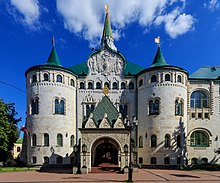
Leading architects of modern architecture are Vladimir Kovalenko, Evgeny Pestov and Alexander Kharitonov. Examples include: the Garantia Bank, the Golden House, the expansion of the Comedy Theater, the Dom Kutscha , the Kaskade , the Bashnya reproductor , the Pila , the Oktyabrskaya Hotel , the artist's house, the Dynamo Stadium, the The Wetter residential building , the periscope, the Titanik commercial building and the house with the mirror .
Art museum
A special position enjoys the art museum with over 12,000 exhibits, including works by outstanding Russian artists as Viktor Vasnetsov , Karl Bryullov , Ivan Ivanovich Shishkin , Ivan Nikolaevich Kramskoi , Ilya Repin , Isaak Ilich Levitan , Ernst Neizvestny , Vasily Ivanovich Surikov , Iwan Konstantinowitsch Aiwasowski , and larger collections by Boris Michailowitsch Kustodijew and Nicholas Roerich .
The museum also houses a large collection of Western European art with works by David Teniers the Younger , Bernardo Bellotto , Lucas Cranach the Elder , Pieter de Grebber , Giuseppe Maria Crespi , a vedute by Giovanni Battista Piranesi and many more.
The exhibits of the Russian avant-garde with works by Kasimir Malewitsch , Wassily Kandinsky , Natalija Goncharova , Mikhail Larionov and others, as well as the rich collection of East Asian art , also attract attention .
open air museum
The Museum of Architecture and the Lives of People in the Volga Region of Nizhny Novgorod is a museum of wooden architecture of the villages of the 19th century and includes several wooden churches on 35 hectares of museum space.
University library
The library emerged from the public library founded in 1831. With 4.3 million objects, including 40,000 books from all epochs from the 16th century onwards, as well as over 600 manuscripts from the 15th century, with the only copy of the Latuchin Chronicle from the 17th century, it is one of the largest and major libraries worldwide.
Opera
The opera in Nizhny Novgorod enjoys worldwide fame, the ballet troupe is very exquisite and gives guest performances all over the world.
Playhouse
Acting is very popular in the city; the theater has an experimental and modern orientation. The magnificent and architecturally significant theater building was built at the end of the 19th century by the German-Russian architect Wiktor Schröter from Saint Petersburg .
Park "Nizhny Novgorod Switzerland"
The “Nizhny Novgorod Switzerland” park is located south of the old town. This serves as a recreational area for the residents of the city.
"Strelka"
The Strelka (German: headland ) at the confluence of the Oka in the Volga is a lookout point on the high Volga. It is a magnet for tourists.
Sakharov Museum
The ⊙ Museum is located in a prefabricated housing estate in the apartment in which the physicist , dissident and Nobel Peace Prize winner Andrei Sakharov lived during his exile from 1980 to 1986. A marble monument dedicated to him has been erected on the street in front of the museum.
Fair
The legendary Nizhny Novgorod Fair was founded in 1817 and emerged from the Makaryevo Fair . It was one of the most important trading markets of pre-revolutionary Russia, the fur trader Emil Brass even called it "the most famous fair in the world". The 19th century AA Betankur exhibition building is a magnificent structure with a steel-glass-ceiling construction. The Transfiguration Cathedral by Auguste de Montferrand , who also created the St. Isaac's Cathedral in Saint Petersburg , is also located on the exhibition grounds . Today the mass has risen again.
Hyperbolic tower
In the vicinity of Nizhny Novgorod stands a unique hyperbolic power line pylon erected in 1929 by the Russian engineer , inventor, and polymath Vladimir Shukhov .
Nizhny Novgorod Stadium
In the middle of the city, next to the confluence of the Oka with the Volga, is the Nizhny Novgorod football stadium . Six games of the 2018 World Cup took place in this arena. After the end of the tournament, the stadium was to be converted into a multifunctional sports complex.
Economy and Infrastructure
Industry
Nizhny Novgorod is not just an old trading town, but an important industrial location. The city is the seat of Russia's largest automobile manufacturer, Gorkovsky Avtomobilny Sawods - GAZ ( Russian Горьковский автомобильный завод - ГАЗ ). In the sprawling factory complex "Krasnoye Sormovo", to which as of July 1945, a prison camp near the Volga River port belonged, were since the summer of 1941 in the factory ( Zavod 112) tanks of type T-34 manufactured. The associated shipyard still builds submarines today, e.g. B. the project 877 . Furthermore, the part of the major industrial Sokol Aircraft Factory of MiG .
traffic
Long-distance transport
Nizhny Novgorod is located on the Trans-Siberian Railway from Moscow to Vladivostok. The city's main train station is called Moscow Railway Station . The city is the administrative seat of the Gorkier Regional Directorate of the Russian State Railways . The directorate not only operates all railway lines and the associated infrastructure in the greater Nizhny Novgorod area, but also a rail network over 5296 kilometers from eastern central Russia via the central Volga region to the Central Urals.
Nizhny Novgorod has an international airport ( IATA code GOJ ) that is served by Lufthansa (as of 2008), among others.
Nizhny Novgorod is connected to the Russian capital Moscow via the M7 Volga highway . At the same time, the city is the starting point of the junction R158 , which leads in a south-easterly direction via Arsamas , Saransk and Pensa to Saratow .
From the city's Volga port , shipping is possible to the Caspian Sea , Baltic Sea , White Sea , Black Sea and Azov Sea .
Inner-city traffic

On May 8, 1896 (according to the old calendar, Julian calendar ) the Nizhny Novgorod tram was opened. With its 198 kilometers long route network, it handles a large part of the local public transport within the city together with numerous bus routes.
The Nizhny Novgorod Metro was added in 1985, and the Nizhny Novgorod S-Bahn on June 24, 2013 .
The Volga cable car between Nizhny Novgorod and the city of Bor on the opposite bank of the Volga has been in regular operation since February 9, 2012 . The 3661 m long track was built by POMA . It crosses the Volga with its maximum span of 900 m between two 82 m high supports.
The Gorky Children's Railway is a narrow-gauge park railway with three stations.
Further educational institutions
- Academy of Civil Service of the Volgo-Vyatsk Oblast
- Branch of the University of Economics
- Branch of the Regional Public University
- Branch of the Russian Public Technical University for Transport Connections
- Branch of the Nizhny Novgorod State University
- Branch of the Nizhny Novgorod Institute of Humanities
- Branch of the Moscow Institute of Economics, Management and Law
- Nizhny Novgorod Trade Institute
- Institute of Management and Business Nizhny Novgorod
- Institute for Rehabilitation
- Nizhny Novgorod Legal Institute of the Ministry of Interior of Russia
- State M. I. Glinka Conservatory Nizhny Novgorod
- Nizhny Novgorod Law Academy
- State Academy of Waterways Transport of the Volga Region
- Nizhny Novgorod State Agricultural Academy
- Nizhny Novgorod State Linguistic University of Nizhny Novgorod
- Nizhny Novgorod State Medical Academy
- Nizhny Novgorod State Lobachevsky University
- Nizhny Novgorod State Pedagogical University
- Nizhny Novgorod State Technical University
- Nizhny Novgorod State University of Architecture and Construction
- State Engineering Pedagogical Institute of the Volga Region
Sports
One of the best-known sports clubs in Nizhny Novgorod is the HK Torpedo Nizhny Novgorod ice hockey club , which takes part in the Continental Hockey League (KHL) . Its home arena is the multi-purpose hall KRK Nagorny , modernized in 2007 , which has almost 5,600 seats and is used not only for ice hockey games but also for events in various indoor sports as well as for concerts and exhibitions. The hall is also used by the women's ice hockey club SKIF Nizhny Novgorod , which won the IIHF European Women Champions Cup in 2008/09 .
In football , the city is or was represented by the numerous clubs FK Nizhny Novgorod , FK Volga Nizhny Novgorod , FK Spartak Nizhny Novgorod and FK Lokomotive Nizhny Novgorod , who played in the highest Russian class, the Premjer League , for several seasons However, they are either represented in the second division , which is two classes lower , or can only be found in the amateur field . The city has its own venue with the Locomotive Stadium, which opened in 1932 and can hold up to 17,856 spectators .
After Russia won the bid to host the 2018 World Cup , it became known that Nizhny Novgorod was also planned as the venue. For this purpose, the new Nizhny Novgorod stadium with a capacity of around 45,000 spectators was built by May 2018 . After it was used for the 2018 World Cup, the home games of the new, local club Olimpiyets Nizhny Novgorod will also be played there.
The bandy club HK Start Nizhny Novgorod takes part in the game operations of the Super League . The city is also home to the BK Nizhny Novgorod basketball club from the VTB United League .
Town twinning
Nizhny Novgorod has partnerships with the following cities:
|
|
Personalities from Nizhny Novgorod
sons and daughters of the town
Celebrities who lived and worked in Nizhny Novgorod
- Maksim Bahdanowitsch (1891–1917), Belarusian poet
- Max Hoelz (1889–1933), German communist and victim of the Soviet secret service
- Andrei Sakharov (1921–1989), Nobel Peace Prize Laureate
- Taylor Rochestie (born 1985), basketball player
- Denis Cheryshev (* 1990), football player
Climate table
| Nizhny Novgorod | ||||||||||||||||||||||||||||||||||||||||||||||||
|---|---|---|---|---|---|---|---|---|---|---|---|---|---|---|---|---|---|---|---|---|---|---|---|---|---|---|---|---|---|---|---|---|---|---|---|---|---|---|---|---|---|---|---|---|---|---|---|---|
| Climate diagram | ||||||||||||||||||||||||||||||||||||||||||||||||
| ||||||||||||||||||||||||||||||||||||||||||||||||
|
Average monthly temperatures and rainfall for Nizhny Novgorod
Source: Roshydromet
|
|||||||||||||||||||||||||||||||||||||||||||||||||||||||||||||||||||||||||||||||||||||||||||||||||||||||||
Trivia
The main belt asteroid (7736) Nizhnij Novgorod , discovered on September 8, 1981, was named after the city.
literature
- Яков Гройсман (Jakov Grojsman, ed.): Нижний Новгород в обчективе века (Nishny Novgorod through Lenses of Century) . Russian and English, Деком (Dekom) 2004, ISBN 5-89533-087-8 .
Web links
- Administration of Nizhny Novgorod
- The Kremlin (Russian)
- Lobachevsky State University (English)
- State Art Museum (Russian / English)
Individual evidence
- ↑ Мэр Нижнего Новгорода Владимир Панов сложил полномочия. May 6, 2020, accessed May 6, 2020 .
- ↑ Itogi Vserossijskoj perepisi naselenija 2010 goda. Tom 1. Čislennostʹ i razmeščenie naselenija (Results of the All-Russian Census 2010. Volume 1. Number and distribution of the population). Tables 5 , pp. 12-209; 11 , pp. 312–979 (download from the website of the Federal Service for State Statistics of the Russian Federation)
- ↑ Russia - Biggest Cities 2018. Accessed December 1, 2019 .
- ↑ General plan of the city of Nizhny Novgorod ( Memento of March 6, 2016 in the Internet Archive )
- ↑ a b Evelyn Scheer, Andrea Hapke: Moscow and the Golden Ring - Old Russian cities at Moskva, Oka and Volga. Trescher, Berlin 2003. ISBN 3-89794-024-8 .
- ^ German prisoners of war of the Second World War. Erich Maschke (ed.): On the history of the German prisoners of war of the Second World War. Verlag Ernst and Werner Gieseking, Bielefeld 1962–1977.
- ^ The decree “On the occasion of the 800th anniversary of the founding of the city of Nizhny Novgorod” .
- ^ Official portal of the city of Nizhny Novgorod. In: НижнийНовгород.РФ . August 29, 2011, Retrieved November 4, 2014 (Russian).
- ↑ http://newsnn.ru/news/35670
- ↑ http://newsnn.ru/news/94060
- ↑ TV documentary about the Volga and the cities around it, 2017. Broadcast on arte .
- ↑ Emil Brass : From the realm of fur . 1st edition, published by the "Neue Pelzwaren-Zeitung and Kürschner-Zeitung", Berlin 1911, p. 214.
- ↑ Нижегородская городская электричка совершила свой первый рейс. Retrieved July 2, 2017 (Russian).
- ↑ Website of the cable car operator NNKD (Russian)
- ↑ 2018 FIFA World Cup ™ in eleven venues. In: fifa.com. FIFA, September 29, 2012, accessed November 21, 2013 .
- ↑ stadiumdb.com: Stadium Nizhny Novgorod (English)
- ↑ Official website of the city of Nizhny Novgorod: International Relations ( Memento of September 2, 2016 in the Internet Archive )






